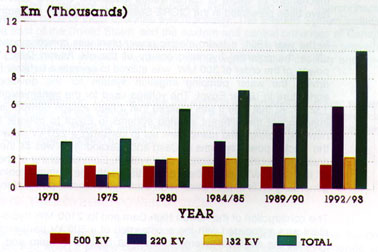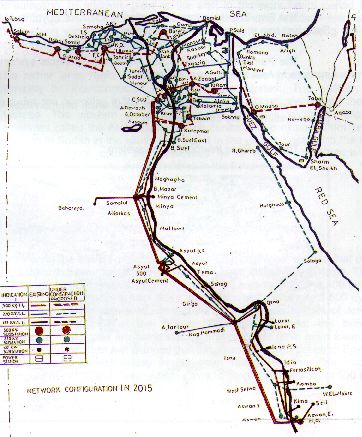
|
| home
| back | next
|
2. EVOLUTION OF THE EGYPTIAN POWER SYSTEM
|
The
first electric power system in Egypt
was introduced about one hundred years
ago when a private company was given
the concession to generate and distribute
electricity for lighting purposes
in Cairo city and then was given another
concession to operate an electricity
system in Alexandria. The transmission
voltages at that time were within
the medium voltage range of 2000 -
6000 volts. At later stages of development,
diesel plants with low voltage distribution
network were installed in the main
cities for lighting purposes.
In the early 1930's, the Egyptian
government started land reclamation
programs, where electrically driven
pumps were needed for water drainage
in the Delta region in north Egypt
and for lifting water from the Nile
river to irrigate the reclaimed land
in upper Egypt. Small steam turbine
plants were installed with ratings
of the order of 1000 - 2500 kW. Long
transmission lines were designed and
constructed to operate at the voltage
level of 66 kV. However, it was then
realised that insulators for the transmission
lines and outdoor switchgear, which
were designed according to the European
experience, were not suitable for
operation in the prevailing environments
in Egypt and the transmission system
had to be operated at 33 kV instead
of 66 kV.
Field investigations were carried
out to study this environmental phenomenon.
This was followed by laboratory investigations
and testing on transmission line insulation
which resulted in the development
of pioneer theories on the mechanism
of failure of contaminated insulators.
Several reports in this field have
been presented in the CIGRE Sessions
by Egyptian research workers.
In the year 1961, a hydroelectric
power plant was commissioned at Aswan
to utilize the potential hydraulic
energy of the old Aswan dam. The available
power, of the order 300 MW, was utilized
to operate a fertilizer factory and
for driving the water pumping irrigation
system for the development of the
agriculture in Upper Egypt. The voltage
used for the transmission network
was 132 kV. At that time it was realized
that a high voltage network is necessary
to interconnect the different isolated
systems in Egypt to operate in one
unified network. Studies and plans
were set to construct a 220 kV network
to connect the electric power systems
of Cairo and Alexandria as well as
the irrigation and drainage electricity
network in one system. Commissioning
of the first sections of this 220
kV system began in 1967 with the commissioning
of the first generating units of the
Aswan High Dam hydroelectric power
plant.
The construction of the Aswan High
Dam and its 2100 MV hydroelectric
power plant was associated with the
construction of a 500 kV transmission
system to transmit the available energy
to the load centers in Cairo and other
parts of Egypt where the 200 kV and
132 kV networks distribute the energy
to the subcenters. It is worthy to
mention that at the mid 1960's the
500 kV voltage level was the highest
voltage used in the world and Egypt
was one of the pioneers in this voltage
level besides USA & USSR.
Because of the localization of the
inhabited area within the valley of
the Nile river, the high voltage transmission
system was also limited to the valley
and the Nile Delta in the north. However,
with the plans of economic and social
development, extensions of the high
voltage networks are being implemented
to reach most of the country. In the
east, 500 kV lines are under construction
to reach the borders of Egypt to interconnect
to Jordan. In the west, 220 kV lines
are under construction along the Mediterranean
Sea coast to reach the borders of
Egypt with Libya.
In the year 1993, the total length
of the high voltage transmission system
(500 kV, 220 kV, and 132 kV) was about
10000 km. The total demand on this
system was about 7000 MW.
Evolution of Transmission Lines Lengths (1970
- 1992/93)
The Egyptian power system went through
fast developments during the 1980's
and 1990's. Several power plants
have been installed bringing the
total installed capacity to about
12000 MW. Other power plants are
being constructed in order to cope
with the increase of the future
demand with a unit capacity of 600
MW. Transmission lines extensions
will be implemented in order to
supply the existing load centers
and also reach most of the isolated
systems. It is forecasted that the
electric energy requirements would
be about 113 TWh, in the year 2015,
while the corresponding maximum
demand would be about 17300 MW.
Development of
Egyptian Power System up to 2015
|
| home
| back | next
|
|
| |
|


|
Email
this page to a friend
Updated: 2016/06/30
If you speak another language fluently and you liked this page, make
a contribution by translating
it! For additional translations check out FreeTranslation.com
(Voor vertaling van Engels tot Nederlands)
(For oversettelse fra Engelsk til Norsk)
(Для дополнительных
переводов проверяют
FreeTranslation.com )




